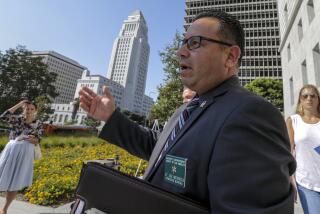Enhanced Photo Analyzed at Denny Trial : Courts: Scientist says the picture shows a dark area on the arm of a man hurling a brick at the truck driver. But he can’t tell for sure if it is a tattoo like the one on the arm of Damian Williams.
- Share via
An enhanced photo shows a dark area that could be a tattoo on the left arm of a man prosecutors say is Damian Monroe Williams, but the scientist who enhanced the print testified Wednesday that he did not know what the spot was.
Leonid I. Rudin, director of research and development at Cognitech Inc., an image processing firm in Santa Monica, said there is definitely something on the man’s arm and that it is consistent with a detailed photo of Williams’ tattoo that prosecutors presented in court.
But when attorney Edi M.O. Faal, who represents Williams, asked whether Rudin knew if the spot were grease, dirt or a tattoo, he answered that he did not.
“Can you tell that the dark spot is a flower?” Faal asked.
“No, we can’t say that with certainty,” Rudin said, adding that he could not say that the spot in the enhanced photo is the same thing depicted in the detailed photo of the tattoo.
Faal then had Williams roll up his left sleeve and let jurors look at the tattoo of a rose on his left arm while comparing it to the photo.
Williams, 20, and Henry Keith Watson, 29, are charged with attempting to kill trucker Reginald O. Denny as rioting broke out at the intersection of Florence and Normandie avenues last year. They are also charged with assaulting or robbing seven other people at the intersection.
Rudin was allowed to testify over Faal’s objection after Superior Court Judge John W. Ouderkirk ruled that the process used to enhance the photo was reliable enough to be used as evidence.
*
Other photos enhanced by different image-processing techniques already have been used in this trial, but Faal had argued--with the jury out of the courtroom--that there is no record that the segmentation process used on the photo has been used for identification in court before.
Rudin testified that the process is used to identify and track oil spills in photos shot from satellites, and that it is used in medicine to identify tumors.
In the photo at issue Wednesday, Rudin testified with the jury present that he extracted an area equal to 1/6,000th of the original, focusing on a man’s left arm. The photo, shot by Santa Monica Evening Outlook photo editor Robert Clark, shows a man in a follow-through motion after throwing a brick that hit Denny in the head. Clark testified Tuesday that he believes the man in the photo is Williams.
The enhanced photo shows a dark spot that could be anything, Faal said outside court. “The tattoo is of a flower,” he said. “The photograph is inconsistent with the tattoo.”
After all the legal tussling over whether the processed image is consistent with Williams’ tattoo, and why the enhanced photo did not capture the rose’s stem, Deputy Dist. Atty. Janet Moore had one question for Rudin:
In all of the processed images, is there an area of coloration on the left arm below the elbow? Rudin said yes.
Rudin was followed by Los Angeles Police Detective Arthur Daedelow, who supervised the investigation of crimes committed at Florence and Normandie. Prosecutors said Daedelow will be their last witness.
But before he completes his testimony, the defense will be allowed to put one of its witnesses, a physician, on the stand. The highly unusual move became necessary, Faal said, because the physician only will be available to testify today.
Daedelow testified that investigators were initially aware of only two victims at the intersection--Denny and another trucker, Larry Tarvin. He said officers went to broadcast and print media seeking videotapes and still photos that could be used to identify other victims, witnesses or suspects, but received “zero cooperation.”
Investigators began taping riot footage from news broadcasts and some officers were able to identify suspects from videotape and news photos, he said. Also, citizens began calling with leads. As detectives and FBI agents developed more evidence, investigators focused on five suspects, including Williams and Watson, who were arrested in post-midnight raids on May 12, 1992, he said.
A television news crew from KCBS-TV Channel 2 was present at Williams’ arrest only because a reporter had learned that arrests would be made that night.
“I called the television reporter and he gave me an ultimatum,” Daedelow said. To keep the arrest off the 11 p.m. news, “I had to give him exclusive rights to the story. Basically, he had me. In order to ensure the element of surprise, I agreed that he and the film crew could accompany me in the execution of the warrant.”
More to Read
Sign up for Essential California
The most important California stories and recommendations in your inbox every morning.
You may occasionally receive promotional content from the Los Angeles Times.













